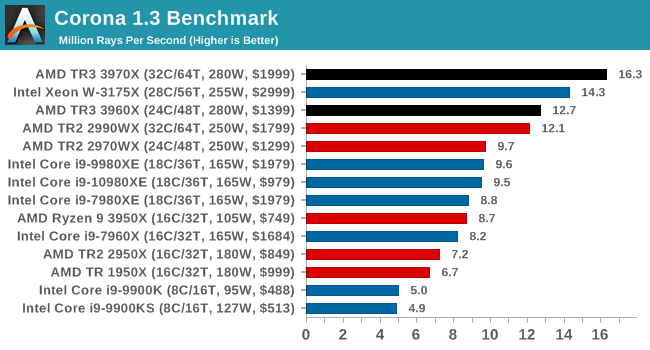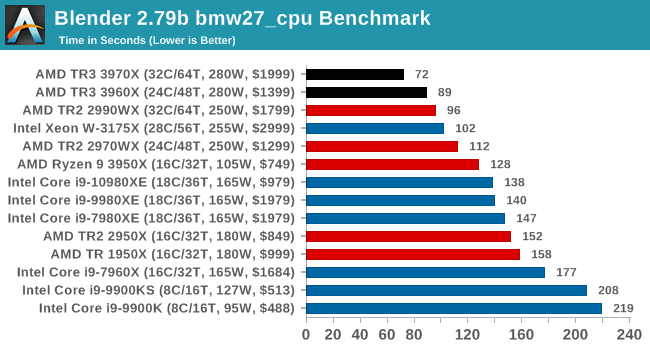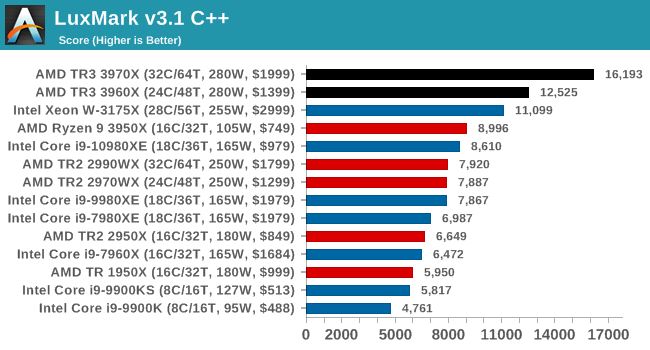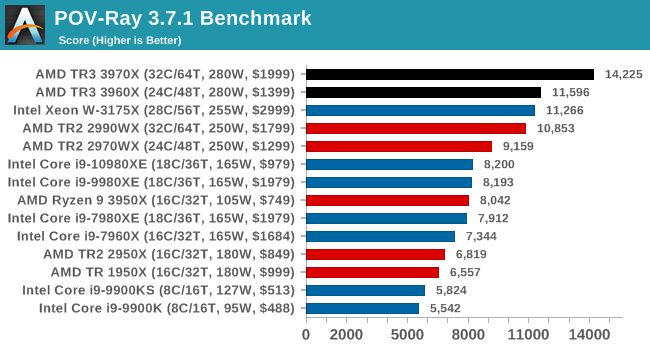The AMD Ryzen Threadripper 3960X and 3970X Review: 24 and 32 Cores on 7nm
by Dr. Ian Cutress, Andrei Frumusanu & Gavin Bonshor on November 25, 2019 9:05 AM ESTCPU Performance: Rendering Tests
Rendering is often a key target for processor workloads, lending itself to a professional environment. It comes in different formats as well, from 3D rendering through rasterization, such as games, or by ray tracing, and invokes the ability of the software to manage meshes, textures, collisions, aliasing, physics (in animations), and discarding unnecessary work. Most renderers offer CPU code paths, while a few use GPUs and select environments use FPGAs or dedicated ASICs. For big studios however, CPUs are still the hardware of choice.
All of our benchmark results can also be found in our benchmark engine, Bench.
Corona 1.3: Performance Render
An advanced performance based renderer for software such as 3ds Max and Cinema 4D, the Corona benchmark renders a generated scene as a standard under its 1.3 software version. Normally the GUI implementation of the benchmark shows the scene being built, and allows the user to upload the result as a ‘time to complete’.
We got in contact with the developer who gave us a command line version of the benchmark that does a direct output of results. Rather than reporting time, we report the average number of rays per second across six runs, as the performance scaling of a result per unit time is typically visually easier to understand.
The Corona benchmark website can be found at https://corona-renderer.com/benchmark

Being fully multithreaded, we see the order here follow core counts. That is except for the 32-core 2990WX sitting behind the 24-core 3960X, which goes to show how much extra performance is in the new TR generation.
Blender 2.79b: 3D Creation Suite
A high profile rendering tool, Blender is open-source allowing for massive amounts of configurability, and is used by a number of high-profile animation studios worldwide. The organization recently released a Blender benchmark package, a couple of weeks after we had narrowed our Blender test for our new suite, however their test can take over an hour. For our results, we run one of the sub-tests in that suite through the command line - a standard ‘bmw27’ scene in CPU only mode, and measure the time to complete the render.
Blender can be downloaded at https://www.blender.org/download/

We have new Threadripper records, with the 3970X almost getting to a minute to compute. Intel's nearest takes almost as long, but does only cost half as much. Again, the 3960X puts the 2990WX in its place.
LuxMark v3.1: LuxRender via Different Code Paths
As stated at the top, there are many different ways to process rendering data: CPU, GPU, Accelerator, and others. On top of that, there are many frameworks and APIs in which to program, depending on how the software will be used. LuxMark, a benchmark developed using the LuxRender engine, offers several different scenes and APIs.
In our test, we run the simple ‘Ball’ scene. This scene starts with a rough render and slowly improves the quality over two minutes, giving a final result in what is essentially an average ‘kilorays per second’.

Our LuxMark test again pushes both TR3 processors out in the lead.
POV-Ray 3.7.1: Ray Tracing
The Persistence of Vision ray tracing engine is another well-known benchmarking tool, which was in a state of relative hibernation until AMD released its Zen processors, to which suddenly both Intel and AMD were submitting code to the main branch of the open source project. For our test, we use the built-in benchmark for all-cores, called from the command line.
POV-Ray can be downloaded from http://www.povray.org/

More rendering, more wins for AMD. More losses for the 2990WX, even though on these tests it still beats the 10980XE quite easily.











245 Comments
View All Comments
Supercell99 - Tuesday, November 26, 2019 - link
I tend to agree, they can low ball AMD for a few years until the catch up. Assuming they completely screw up the 10 nm deployment going into 2022. It takes 3-5 years for for an industry to fully adopt switch course on a mainstream microprocessor.Korguz - Tuesday, November 26, 2019 - link
" they can low ball AMD for a few years until they catch up " not if their investors and shareholders have anything to say about that......Chaitanya - Monday, November 25, 2019 - link
Impressive to say the least.Paul-RP12 - Monday, November 25, 2019 - link
Intel destroyed. This is the end, this is the sunset of the empireyankeeDDL - Monday, November 25, 2019 - link
I wonder how long will it take Intel to go fabless. Now, that would be a shift ... I think it is inevitable.milkywayer - Monday, November 25, 2019 - link
That's what you get for milking the same s****y 4 core cpus for years until the competition not only catches up but also surpasses you. Intel deserved every bich slap this year from AMD.Paul-RP12 - Monday, November 25, 2019 - link
Intel has no chance. they do not have an effective architecture, they do not have a modern technical process. They are hopelessly behind. 3970x of 2000 usd upside about 20% (in applications that use all the cores) Xeon W-3175X of 3000 usd. Its so crazy!!TEAMSWITCHER - Monday, November 25, 2019 - link
Intel's quarterly profit is still more than AMD's revenue. AMD can't make enough products to change that.eva02langley - Monday, November 25, 2019 - link
I said 10 years last year... so maybe around 9 now.niva - Monday, November 25, 2019 - link
I hope they never go fabless, it will be a big problem for consumers in the end... unfortunately it may happen.